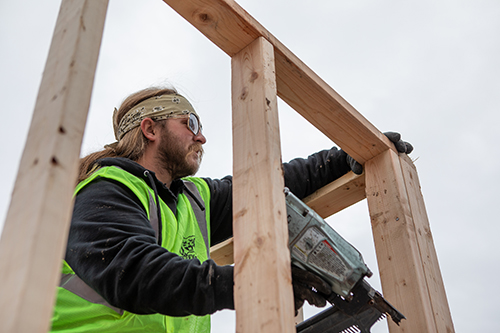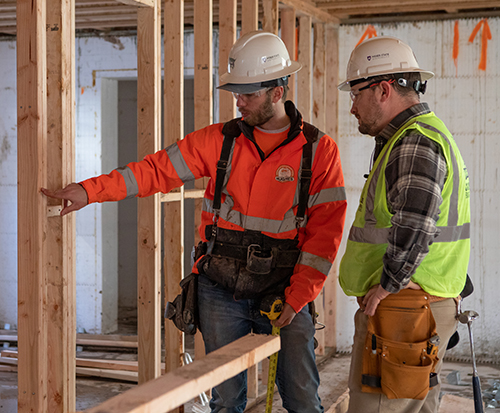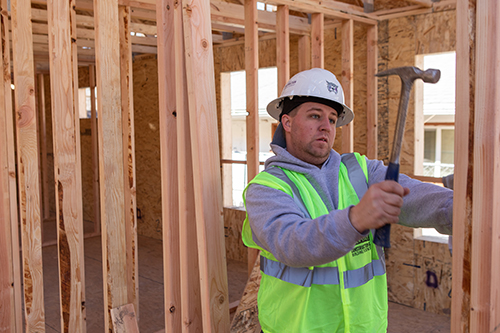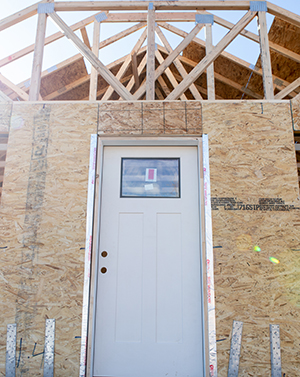Ogden City Supports WSU Students Building Sustainable Home for National Competition
OGDEN, Utah – An innovative collaboration between Weber State University and Ogden City means students are constructing a new all-electric home at 2807 Quincy Ave, Ogden, with plans for additional homes in the future. The home will be available for public tours May 22-24 and 29-31.
 Students from the Department of Construction & Building Sciences in WSU’s College of Engineering Applied Science & Technology make up the senior project team. They are finalists in a two-year competition called the 2020 Department of Energy Solar Decathlon. Ten teams from around the world design and construct highly efficient and innovative buildings powered by renewable energy. The two winning teams will be announced during the Smithsonian Folklife Festival in Washington D.C., July 1-5.
Students from the Department of Construction & Building Sciences in WSU’s College of Engineering Applied Science & Technology make up the senior project team. They are finalists in a two-year competition called the 2020 Department of Energy Solar Decathlon. Ten teams from around the world design and construct highly efficient and innovative buildings powered by renewable energy. The two winning teams will be announced during the Smithsonian Folklife Festival in Washington D.C., July 1-5.
Janae Thomas, who is graduating in April, is the student project manager. She took on the monumental task because her daughter's future depends on making a difference today in transportation, housing and urban planning.
“I found myself in construction because of the industry’s ability to directly impact environmental concerns and human wellbeing,” Thomas said. “This house showcases numerous economic solutions to improve Utah’s air quality. This house is simple to reproduce, inviting to live in and built to last generations. I’ll be proud to drive by this house and tell my children, and their children, I built that. My journey at Weber State has opened doors I never thought possible. To all my professors, directors, presidents, and industry partners, thank you for the opportunities to learn.”
The Quincy Avenue home is designed to make the “True Cost of Ownership”' affordable by nearly eliminating all energy bills. Energy costs to operate the home are estimated at just over $100 annually or around $9 per month to be connected to the electrical grid. The home supports the mission of the Ogden Civic Action Network, which is committed to revitalizing the east central neighborhood in Ogden, with support from Weber State and many other Ogden institutions.
The building lot had been empty for nearly 10 years after a dilapidated four-plex was torn down. The Craftsman Architectural Style home was designed to not only nestle in nicely with other homes on this historical avenue but also showcase how homes can provide a net-zero energy lifestyle.
 “We are excited to provide our students with the opportunity to gain invaluable green design and construction experience by working alongside professionals in the field while simultaneously creating a final product that benefits the community,” said Jeremy Farner, WSU Building Design & Construction associate professor. “Sustainable homes are not just better for the planet, they are better for the people living in them. They contribute to high indoor environmental quality which is associated with good mental and physical health and significantly lower utility bills which makes the home more affordable.”
“We are excited to provide our students with the opportunity to gain invaluable green design and construction experience by working alongside professionals in the field while simultaneously creating a final product that benefits the community,” said Jeremy Farner, WSU Building Design & Construction associate professor. “Sustainable homes are not just better for the planet, they are better for the people living in them. They contribute to high indoor environmental quality which is associated with good mental and physical health and significantly lower utility bills which makes the home more affordable.”
The 2,540 total square foot home (1,270 on main and 1,270 in a full basement) will have 2,370 finished square feet with six bedrooms, two bathrooms, and two family rooms. It incorporates portable battery backup technology to power the home’s critical functions for up to 72 hours if the electrical grid were to go down in a natural disaster or emergency. Not only will the solar array generate enough energy to offset the energy usage of the home annually, but it will also generate enough electricity to charge an electric vehicle to travel 20 miles per day.
The lot was obtained as part of an agreement with Ogden City to show its commitment to revitalize neighborhoods and breathe new life into historic districts. With support from a number of Weber State groups and Ogden City groups, the university established the Student Construction Capital Revolving Fund. When the current home is sold, the proceeds will be reinvested into the fund to continually repeat the process.
“Ogden City is excited to build on our already great relationship with Weber State University,” said Ward Ogden, Ogden City Community Development director. “Building a net-zero home that is complementary to the surrounding historic neighborhood will not only demonstrate that affordable, sustainable construction methods and materials are a viable option, but also this project will also provide opportunities for students to gain hands-on experience with various aspects of design, construction, marketing and sales."
The home will be connected to the electrical grid, which acts essentially like a battery. Excess energy not being used during the day or on sunny days is put back on the grid for other neighbors and businesses to use, then the reverse is true when the home requires more energy than the solar array is producing, such as in the evening or on shady days. The net result of energy export and import is net-zero annually.
 A report released by the Energy Information Administration in September 2018 found that 31% of U.S. households struggle to pay their energy bills. The same study found that about 20% of those surveyed had to go without essential needs such as food or medicine to pay utility bills. The 2016 report from the American Council for an Energy-Efficient Economy called “Lifting the High Energy Burdens in America’s Largest Cities: How Energy Efficiency Can Improve Low-Income and Underserved Communities” found that low-income households spend 7.2% of household income on utilities. This percentage was more than three times higher than the percentage of income spent on utilities by higher-income households.
A report released by the Energy Information Administration in September 2018 found that 31% of U.S. households struggle to pay their energy bills. The same study found that about 20% of those surveyed had to go without essential needs such as food or medicine to pay utility bills. The 2016 report from the American Council for an Energy-Efficient Economy called “Lifting the High Energy Burdens in America’s Largest Cities: How Energy Efficiency Can Improve Low-Income and Underserved Communities” found that low-income households spend 7.2% of household income on utilities. This percentage was more than three times higher than the percentage of income spent on utilities by higher-income households.
Utah is no exception when it comes to utility insecurity. According to the United Way Utah 211 Program Annual Report (2016-2017), utility payment is the No. 1 assistance request. Sustainable and net zero homes can significantly reduce or eliminate major utility bills like water, natural gas and electricity, making homeownership significantly more affordable.
The home on Quincy Avenue showcases technology such as Variable Refrigerant Flow HVAC, Air Source Heat Pump Water Heating, and Energy Recovery Ventilation to keep the super-insulated and airtight home continuously filled with fresh pre-conditioned air.
The building envelope of the home uses readily accessible products that require the super-efficient HVAC to heat or cool the air within the home less than once an hour where most new homes today require the air to be conditioned four to seven times per hour.
“Weber State loves to use the phrase “Build it tight; ventilate it right,” Farner said. “We will use an aerobarrier that will seal the home much tighter than is required by current energy code.”
The roof uses Raised Heel Energy Trusses to allow insulation in the attic to be extended to the edge of the exterior walls. This helps to maintain conditioned air inside the home as well as prevent the leading cause of ice dams on homes in Utah.
Groups supporting the Student Construction Capital Revolving Fund include
 The College of Engineering, Applied Science & Technology
The College of Engineering, Applied Science & Technology- Weber State University Financial Services
- Weber State University Facilities Management
- Weber State University Provost Office
- OgdenCAN
- Ogden City Department of Community and Economic Development
- Weber State University College of Social & Behavioral Sciences
- Weber State University College of Science
10 teams competing in the 2020 Solar Decathlon
- Hogeschool Utrecht University of Applied Sciences Utrecht, Utrecht, Netherlands
- Kansas State University, Manhattan, Kansas
- Universidad Técnica Federico Santa María, Valparaíso, Chile
- University of Colorado, Boulder, Colorado
- University of Denver, Denver, Colorado
- University of Illinois at Urbana-Champaign, Urbana, Illinois
- University of Nevada, Las Vegas, Las Vegas, Nevada
- University of the Witwatersrand, Johannesburg, Johannesburg, South Africa
- University of Waterloo, Waterloo, Ontario
- Weber State University, Ogden, Utah
For more information or pictures of the project under construction, visit weber.edu/solardecathlon. To follow the team on social media, check out @wsusolardecathlon2020 on Instagram.
For photos, visit the following link.
wsuucomm.smugmug.com/Colleges-and-Departments/Applied-Science-and-Technology/Net-Zero-Home
Visit weber.edu/wsutoday for more news about Weber State University.
Allison Barlow Hess, Public Relations director
801-626-7948 • ahess@weber.edu- Contact:
Allison Barlow Hess, Public Relations director
801-626-7948 • ahess@weber.edu